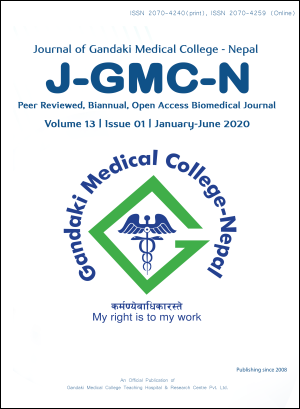Outcome of diagnosed cases of appendicitis and diagnostic accuracy of ultrasound of the appendix
DOI:
https://doi.org/10.3126/jgmcn.v13i1.27691Keywords:
Acute appendicities, Right Iliac Fossa, Ultrasound, UltrasonographyAbstract
Background: Acute appendicitis is the most common condition requiring an emergency ultrasound scan as well as surgery. Several scoring systems for acute appendicitis has been suggested to improve diagnostic accuracy and decrease the negative appendectomy rate. In this study, we have evaluated the diagnostic performance of ultrasound on the diagnosis of acute appendicitis, other appendicular pathology, and correlate with surgical outcome.
Material and methods: This retrospective study included 776 cases of ultrasound scan reports in which the appendix was visualized and not visualized or equivocal. Data were collected from October 2014 to April 2019 from different department and wards of Gandaki Medical College Teaching Hospital and Research Center (GMCTHRC). All the cases with diagnosed acute appendicitis, appendicular lump, and appendicular abscess were included and were followed for its surgical outcome. The surgical note or post-operative findings served as the reference standard for determining whether perforation was present or not.
Result: There were 776 ultrasound scans for suspected appendicitis out of which 423 (54.5%) were diagnosed as appendicular pathology. Out of 423 diagnosed cases, 192 (45.4%) were males and 231 (54.6%) were females, with age ranging from 24 months to 87 years. Sonographic findings, in these positive subjects, suggested acute appendicitis, appendicular lump, abscess, and amount of free fluid in right iliac fossa (RIF) and pelvic cavity. Frank acute appendicitis was present in 378 (89.3%) cases, eight (1.9%) cases had an appendicular abscess, 23 (5.4%) had an appendicular lump and 14 (3.3%) had perforated appendicitis.
Conclusion: We conclude that ultrasound is a good modality for visualization of appendicitis with other appendicular pathology. We could follow a structured report and identify pathology more specifically. Ultrasound is an easy and non-invasive test to investigate.
Downloads
Downloads
Published
How to Cite
Issue
Section
License
This license allows reusers to distribute, remix, adapt, and build upon the material in any medium or format for noncommercial purposes only, and only so long as attribution is given to the creator.




